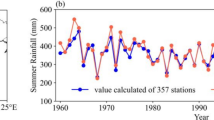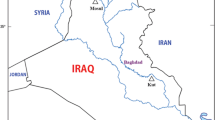Abstract
In this paper, base on the radar rainfall products, a classification model which can forecast rain or shine weather in precipitation nowcasting is established from the data-driven point, and the model is implemented with the Bayesian optimization XGBoost method. Finally, the model results are compared with the SVM method, the Random Rorest (RF) method and the Gradient Boosting Decision Tree (GBDT) method. The results show that the XGBoost method is better than the other three methods on rain or shine weather forecast in precipitation nowcasting. The TS score and the POD are at a high level, so the model has a certain practical value.
Access this chapter
Tax calculation will be finalised at checkout
Purchases are for personal use only
Similar content being viewed by others
References:
Golding, B.W.: Nimrod: a system for generating automated very short range forecasts. Meteorol. Appl. 5, 1–16 (1998)
Pierce, C.E., Collier, C.G., et al.: GANDOLF: a system for generating automated now casts of convective precipitation. Meteorol. Appl. 7, 341–360 (2000)
Li, P.W., Wong, W.K., Chan, K.Y., et al.: SWIRLS-an evolving nowcasting system. Technical Note, Hong Kong Observatory, no. 100 (2000)
Sheng, H., Bing, L., et al.: Storm series algorithms in the SWIFT and application in the second FDP trial. Meteorol. Mon. 36(1), 55–58 (2010). (in Chinese)
Huang, X., Zhao, H., et al.: An genetic neural network ensemble prediction model for tropical cyclones rainfall in Guangxi. J. Nat. disasters 26(6), 184–196 (2017). https://doi.org/10.13577/j.jnd.2017.0621
Chadwick, R., Coppola, E.: An artificial neural network technique for downscaling GCM outputs to RCM spatial scale. Nonlinear Process. Geophys. 18(6), 1013–1028 (2011)
Wu, Q., Zhang, Q., Wan, J.: Application of ANN in weather forecast. Comput. Eng. 31(14), 176–177 (2005). (in Chinese)
He, J., Chen, K., et al.: A multi-time scales SVM method for local short-term rainfall prediction. Meteorol. Mon. 43(4), 402–412 (2017). (in Chinese)
Zhen, Y., Hao, M., et al.: Research of medium and long term precipitation forecasting model based on Random Forest. Water Resour. Power 33(6), 6–10 (2015). (in Chinese)
Chen, T., Guestrin, C.: XGBoost. In: Proceedings of the 22nd ACM SIGKDD International Conference on Knowledge Discovery and Data Mining, KDD 2016, pp. 785–794 (2016)
Breiman, L.: Random Forest. Mach. Learn. 45(1), 5–32 (2001)
Friedman, J.H.: Greed function approximation: a gradient boosting machine. Ann. Stat. 29(5), 1189–1232 (2001)
Mai, X., Zhong, H., Li, L.: Using SVM to provide precipitation nowcasting based on radar data. In: Liu, Y., Wang, L., Zhao, L., Yu, Z. (eds.) ICNC-FSKD 2019. AISC, vol. 1075, pp. 349–356. Springer, Cham (2020). https://doi.org/10.1007/978-3-030-32591-6_37
Bergstra, J., Yamins, D., Cox, D.D.: Hyperopt: a Python library for optimizing the hyperparameters of machine learning algorithms. In: SciPy 2013 (2013)
Acknowledgement
This research was financially supported by the Natural Science Foundation of Guangxi (NO. 2018JJA150144, 2018GXNSFAA294079) and the National Science Foundation of China (NO. 61562008, 41401524, 4166010274).
Author information
Authors and Affiliations
Editor information
Editors and Affiliations
Rights and permissions
Copyright information
© 2021 The Author(s), under exclusive license to Springer Nature Switzerland AG
About this paper
Cite this paper
Mai, X., Zhong, H., Li, L. (2021). Research on Rain or Shine Weather Forecast in Precipitation Nowcasting Based on XGBoost. In: Meng, H., Lei, T., Li, M., Li, K., **ong, N., Wang, L. (eds) Advances in Natural Computation, Fuzzy Systems and Knowledge Discovery. ICNC-FSKD 2020. Lecture Notes on Data Engineering and Communications Technologies, vol 88. Springer, Cham. https://doi.org/10.1007/978-3-030-70665-4_143
Download citation
DOI: https://doi.org/10.1007/978-3-030-70665-4_143
Published:
Publisher Name: Springer, Cham
Print ISBN: 978-3-030-70664-7
Online ISBN: 978-3-030-70665-4
eBook Packages: Intelligent Technologies and RoboticsIntelligent Technologies and Robotics (R0)




